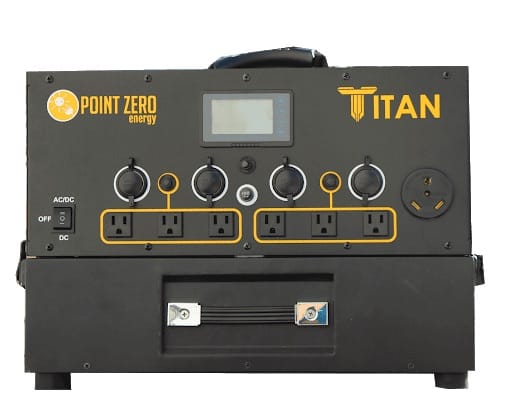With the solar generator market growing as new models are released more often than ever before, I wanted to put together my own list of the best portable power stations out there.
The solar generators I’ve selected vary in size and output power.
I ranked them according to overall value – meaning that they are the best models for what they offer compared to their competition.
The following is a table ranking each solar generator as well as its main specifications.
After the table, I’ll be going more in-depth on each solar generator.
| Model | |||||||
|---|---|---|---|---|---|---|---|
| Ranking | |||||||
| Image | 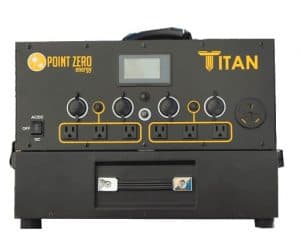 | ||||||
| Battery Capacity | 288Wh+ | 240Wh | 1,260Wh | 1,500Wh | 2,000Wh+ | 505Wh | 1,002Wh |
| AC Inverter Output | 600W Continuous, 1,200W Surge | 200W Continuous, 400W Surge | 1,800W Continuous, 3,300W Surge | 1,000W Continuous, 1,200W Surge | 3,000W Continuous, 6,000W Surge | 500W Continuous, 750W Surge | 1,000W Continuous, 2,000W Surge |
| Solar Input Max | 200W | 42W | 400W | 500W | 2,000W | 120W | 163W |
| Battery Charge Cycles | 500 | 500 | 800 | 1,000 | 2,000 | 500 | 500 |
| Price | $$-$$$ | $ | $$$ | $$$ | $$$$ | $$ | $$$ |
| Check Price | Shop Solar Kits Amazon | Amazon | Shop Solar Kits Amazon | Amazon | Shop Solar Kits | Amazon | Amazon |
| Individual Reviews | Read Full Review | Read Full Review | N/A | N/A | Read Full Review | Read Full Review | Read Full Review |
1. EcoFlow River 600
The EcoFlow R600 has an AC inverter power rating with 600W of continuous power (1,200W surge).
The base River 600 (pictured above) has a battery capacity of 288Wh. The River 600 Max (pictured below) has twice the battery capacity (576Wh).
I have the River 600 Max and it is the best solar generator I own. It can connect to your smartphone and you can access several different features within the EcoFlow application.
It comes with a modular design where you can connect an additional battery to enhance the capacity. The EcoFlow River Max is basically just the standard River 600 with an additional battery.
It consists of three AC outlets and three USB-A ports along with a 100W USB-C port. You’ll also come across a car outlet at 12V and a DC output of 12V for charging directly. You can make use of the car or solar input and the X-Stream AC Input for ultra-fast charging.
It’s capable of relieving and reviving most home appliances such as a coffee maker, rice cooker, TV, and so on.
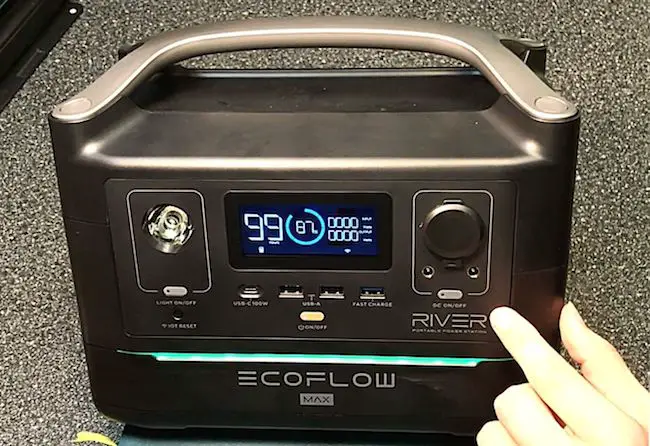
Pros:
- Can control the power station with the help of their app
- Supports the fast charging feature (X-Stream)
- A chainable power station that can double the capacity
Cons:
- Charging wattage lessens if the generator is warm
To attain maximum efficiency, it makes use of MPPT charging technology that supports solar panels of a maximum of 200W. These panels enable you to charge the device fully within two hours.
You can read my complete review and testing of my EcoFlow River Max here: EcoFlow River 600 Review – Testing My River Max + Comparisons.
2. Jackery Explorer 240
The Jackery 240 works as a perfect portable unit, especially when you require power inside where traditional generators can be loud and dangerous.
Not only is the Jackery 240 simple to use, but it has years of history. It currently ranks as the number one best-selling outdoor generator on Amazon.
It has four output ports:
- 2x USB-A
- 1x AC port
- 1x car port
With a weight of 6.61 lbs and a size of 7.87 x 9.05 x 5.24 inches, you can carry it with you wherever you want. Moreover, it comes with a compact lithium battery rated at 240 watt-hours.
This device consists of several outlets, capable of providing sufficient power to charge your essential gadgets.
As for the standard AC wall outlet, it generates 200W of AC power that has a peak capacity of 400W. You will also find three USB ports that will enable you to charge your smartphone or tablet efficiently.
The 12V DC car adaptor can charge several gadgets suitable for DC power, however, this particular generator is not ideal for CPAP machines as it does not have enough battery capacity for that purpose.
Pros:
- Lightweight
- Easily compatible with a Jackery solar panel
- 500+ charge cycles
Cons:
- Slow charge rate for solar and AC
- No USB-C ports
You can read my full review of the Jackery 240 here: The Jackery Explorer 240 Review – Solar Charger for the Outdoors.
With the growing use of USB-C ports on new technology, the Jackery 240 may not be able to charge your devices as fast as possible through its USB-A ports.
If you want a model similar to the Jackery 240 but would rather have updated USB ports, then the next best option is the Jackery Explorer 300.

I own a Jackery 300 and it is slightly bigger than the Jackery 240 in terms of battery size, but it has updated USB-C ports that can be convenient for fast charging.
You can read my review and test of the Jackery 300 here: Jackery Explorer 300 Review & Test (Plus Comparisons).
3. EcoFlow Delta 1300
The EcoFlow Delta 1300 consists of a patented wall charging platform called X-Stream. EcoFlow uses this technology in several power stations of theirs, including the River 600.
This lithium-ion battery has a capacity of 1,260Wh and packs an inverter of 1,800W continuous and 3,300W surge power through its AC outputs. It comes with four USB-A outlets (two standard and two quick-charge ports), six AC outlets, two USB-C ports, and a DC car outlet.
After 800 charges (around three years on average), you will find that the battery capacity retains a 60% efficiency.
You can charge this unit in three ways:
- From a car port that needs only 10-12 hours to recharge fully
- From an AC outlet that can recharge the system fully in 1.6 hours
- From solar panels (up to 400W), which helps you to fully recharge the generator within about four hours
This generator comes with all the cables that you will need for solar charging as well.
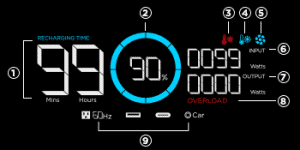
You will also find a huge LCD screen that shows battery charging time and input and output power. Moreover, it has certifications from PSE, CE, RoHS, UL, and the FCC.
Pros:
- Charging time is less than two hours from AC outlet
- Has a shelf life of 12 months
- Can generate an output of 1,800W and has a surge capacity of 3,300W
- Top emergency backup option for its size in case of disasters and medical requirements
Cons:
- Will not charge for up to two hours if the generator is overheated (needs cooling time to reset)
- Needs more power to fill the battery as it has only 58% round trip efficiency
Round trip efficiency is the measure of how much power can be drawn from the battery compared to the amount of power required to charge it up.
The Delta 1300 is capable of powering your cell phone 188 times, laptop 23 times, a 10W light for 36 hours, and coffee maker up to 60 cups.
It can also run power-hungry appliances like a large fridge for 10 hours, microwave for 1-1.8 hours, and a CPAP machine for 18-22 hours.
Similar: Inergy Apex vs EcoFlow Delta 1300 – Which is the Superior Solar Generator?
4. Bluetti EB150
The Bluetti EB150 from MaxOak comes with a massive battery for a generator of this size. The lithium battery has 1,500Wh of capacity due to its high-quality LG cells.
This enables it to power up numerous gadgets for an extended period without needing a recharge.
The Bluetti comes with a pre-installed MPPT charge controller and you can recharge it by using solar panels or an AC wall charger.
While using the wall charger, you can recharge the generator in ten hours. You can also fully recharge the power station in 4-5 hours with 400W of solar panels. However, the generator can take up to 500W of solar, reducing its fastest charging time to about 3-4 hours.
The 1,000W pure sine wave inverter enables you to run the generator at full power until the battery is fully depleted (1,000W continuous, 1,200W surge).
Moreover, it comes with four standard USB-A ports, one quick-charging USB-C PD 45W port, a regulated 12V connection, and two AC outlets.
This unit can recharge your tablet 55+ times, a drone 27 times, laptop 21 times, camera 250+ times, LED light for over 128 hours, TV for 15 hours, and your mini-fridge on your RV for 32+ hours.
Pros:
- Suitable for those having a mobile lifestyle
- Best suited for those who live in areas where grid failures are common
- Made using high-quality components (MPPT, lithium battery, etc.)
- One of the best power stations you can get for the money at the 1,500Wh battery size level
Cons:
- Has only two AC ports
- Inverter surge power is very low compared to similar-sized generators
Similar: Top 7 Solar Generators With MPPT Charge Controllers
5. Point Zero Energy Titan
The Point Zero Energy Titan is a behemoth of a solar generator that can be used for almost any situation.
This modular system comes with the ability to stack batteries and also includes a massive inverter, which makes it one of the strongest solar generator competitors against fossil fuel generators.
It also has two high-end MPPT charge controllers that can take in a whopping 2,000W of solar input combined. However, using 2,000 of solar is only recommended with two batteries attached to the Titan (it comes with one battery – 1,000W max solar input recommended).
The versatility of the integrated lithium-powered battery pack gives it a unique approach.
Moreover, they are expandable to enhance their storage capacity. Each battery connects underneath the main module – That is, it can hold 2,000Wh of power in each battery.
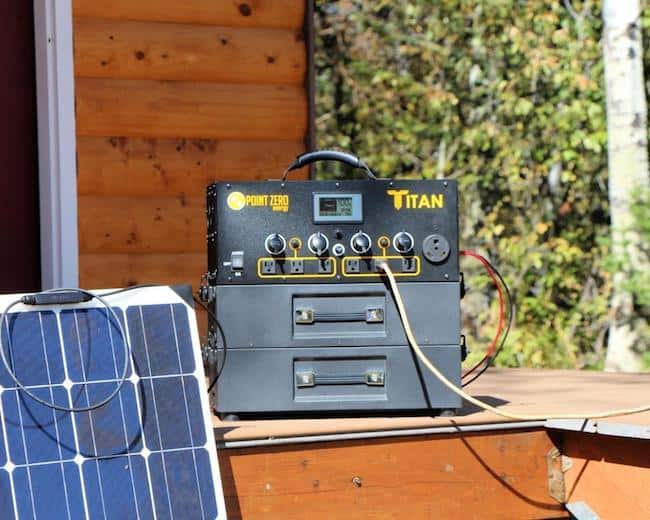
To understand what is going on inside the power unit, it has an informative LCD screen. This will let you know about the battery life, input and output power, and so on.
It displays two USB Type-C ports, four 12V car ports, a 30A RV plug, six standard AC outlets, and six smart USB-A output ports.
The USB ports are attached to a car port connection that plugs into each of the four sockets on the generator. There are four car port USB 30W adaptors included with the Titan (two with two USB-A and two with one USB-A and one USB-C port).
The 12V ports are fully regulated; hence when the battery is low, the DC ports’ output will not be impacted. This allows you to run DC gadgets like a 12V fridge effectively. The pair of three standard outlets have their own 15A fuse that provides current from these plugs simultaneously.
Pros:
- Modular design for many batteries
- Extremely high inverter rating (3,000W continuous, 6,000W surge)
- Extremely high solar input (2,000W max)
Cons:
- Due to its heavy weight, it isn’t nearly as portable as the other options on this list
- Expensive
This power unit is suitable for off-grid cabins, outdoor festivals, powering food trucks, tailgating, and RV use.
The package comes with an AC wall charger, an MC4 adapter, and a car adapter. For detailed info, check out my full Titan review here: Titan Solar Generator Review – The Best Large Solar Generator?
6. Rockpals Rockpower 500
The Rockpals Rockpower 500 is one of the flagship variants of this brand that holds a capacity of 505Wh. This lithium battery packs a 500W continuous pure sine wave inverter that can peak up to 750W.
This makes it suitable for emergency power requirements and most low-powered household appliances.
You will find two covered AC sockets and one covered 12V output port to keep any particles out of the ports when not in use. The 12V car port generates 120W max and a set of 12V DC sockets that can produce 60W max.
Also, it integrates a USB-A quick charging 3.0 port and two standard USB-A ports. This power station further holds a 45-watt bi-directional USB-C outlet.
The presence of the battery management system protects your gadgets from various types of voltage variations that may otherwise cause damages.
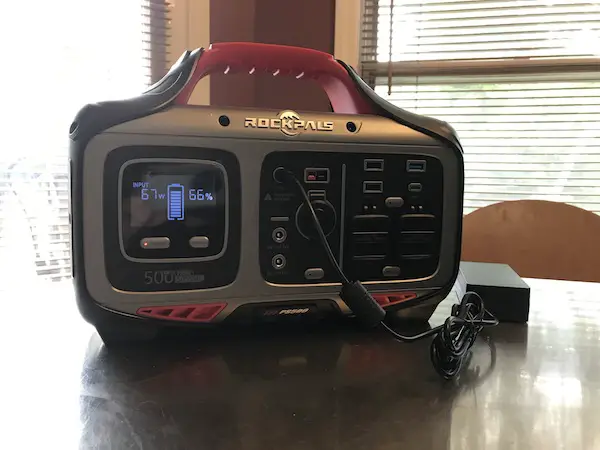
Pros:
- Anderson Powerpole input is fit for several different solar panel types
- Suitable companion for the camper
- Nine total output ports with four of them being USB
- Comes with a warranty of 24 months
Cons:
- Average battery cycle life (500 cycles to 80% battery capacity)
- Average recharging time from wall charger
The Rockpower 500 is the largest and most powerful model in Rockpals’ Rockpower series. They have a Rockpower 200 and 300 model that are more compact.
I have this model on the list because it is less expensive than most similar competitors and it performs well.
For example, the Jackery Explorer 500 has fewer port options than the Rockpower 500, is similar in battery size, yet it costs $50 to $100 more.
I have this exact Rockpals 500 and tested it out for review purposes. But I also used it to recharge my devices and even used it during a short-term power outage.
If you’d like to read my review you can find it here: Rockpals Rockpower 500 Review (Testing, Pricing, and More).
7. Jackery Explorer 1000
The Jackery Explorer 1000 is basically a giant version of its smaller models, like the Explorer 240 and 300.
With a battery capacity of 1,002Wh, an AC inverter capable of 1,000W continuous (2,000W surge), and numerous outputs, it’s capable of meeting the power requirements of most devices.

When it comes to the output options, in the DC area, you will find two USB-C PD 18W outputs, a quick charge 3.0 USB Type-A port, a car port of 12V, and a USB Type-A port of 5V and 2.4A.
As for the AC section, there are three AC outputs of 110V that are activated by pressing the AC button that’s present above the ports. If you go off the grid, you will be able to run computers, communication gadgets, cameras, and CPAP devices.
The charging opportunities are capable of charging your smartphone 100 times, laptop 12 times, and your portable fridge of 60W for 66 hours.
From the wall charger, you can charge the Jackery 1000 from zero to full within a 7-hour time frame. It takes up to 14 hours if you are planning to charge using your car port and about eight hours with 200W of solar panels.
Pros:
- Well-encased in a textured plastic exterior with rubber feet
- Available at an affordable price range
- Capable of storing up to 1 kWh of energy
- The lightest 1,000Wh solar generator (22 lbs.)
Cons:
- Has a USB-C of low output (18W instead of typical 60W)
- The large battery makes it hard to carry around easily (22 lbs for the entire generator)
Except for the left side, which contains a built-in flashlight, all the other ends are quite bare with cooling vents and plastic backing.
The presence of the flashlight with SOS mode makes it efficient for outdoor adventures and emergencies respectively.
Check out my full analysis of the Jackery 1000 here
What Exactly Is a Solar Generator?
A solar generator consists of batteries, an inverter, and a charge controller. This device charges itself through solar panels that run current through the charge controller and into its battery. The inverter emits the power generated from its battery to charge numerous devices and appliances.
The amount of power emitted from the solar generator depends on the capability of its output ports.
As a solar generator gets bigger in terms of battery capacity, its AC ports tend to have a higher maximum continuous output.
Similarly, a larger model will most likely have a higher solar input to reduce recharging times.
Factors to Consider While Selecting a Solar Generator

Now that you’re aware of the best options available in the market, let’s look at the essential aspects you need to consider before you make the final decision.
Here are some of the factors you need to consider while shopping for your solar generator.
1. Battery Capacity
Note the amount of electricity your generator is capable of holding, similar to a water tank.
Battery capacity for solar generators is measured in watt-hours (Wh).
Also, you have to determine the amount of power that the battery can generate at any particular time, which is usually noted in watts.
You don’t have to hunt for the largest battery in the market to get a good solar generator. All you have to question is:
- If the generator delivers sufficient power output (in watts) for your needs
- If the battery is big enough (in watt-hours) to where you don’t have to constantly charge it
2. Battery Types
As you are searching for the battery type essential for your power station, you will find that there are two main types available in the market.
The two most common types of batteries present in portable solar generators are as follows:
Lithium-Ion Battery
Since 1991, these rechargeable batteries have been commercially available in the market. They are well known for their extended life span, energy-dense features, and easily rechargeable formats.
In more detail, the lithium-ion battery has an outstanding energy-to-weight ratio, little to no memory effect, and a very low self-discharge rate.
Lead-Acid Battery
These batteries are the same as a traditional car battery, which is inexpensive.
Moreover, it’s quite heavy and has a shorter life than lithium-ion batteries. For long-term energy storage in a home unit, they act as a powerful backup source.
Similar: Top 10 Affordable Solar Generators From $100-$140 – Best Deals
3. Size & Weight
Several solar generators are lightweight and smaller in size than traditional gas generators. However, you may also come across some brands that are quite bulky and big, as seen from the Point Zero Energy Titan and YETI 3000 Lithium.
Based on what you’re planning to use the generator for, you can select the size that you prefer. In case you wish to take it to the woods as you go camping, it’s important to get the best generator for you that has a great power output but also is lightweight and compact.
However, if you’re planning to charge your refrigerator or other large appliances in case of a power outage, getting a small solar generator will not be helpful.
4. Watts
While hunting for solar panels and solar-powered generators, you will have to pay careful attention to the wattage rating present on the solar panels.
This is otherwise known as the solar PV input. For instance, the PV panel of 100W is theoretically capable of generating 100W of power when kept directly under the sun.
However, this is almost never the case due to efficiency losses from the panel.
Usually, the full sun rays are between the timeframe of 10 AM to 4 PM. Sunlight may still be available after that 4 PM mark; however, the PV input won’t be as high as earlier in the afternoon.
Benefits of Using Solar Generators
Solar generators are famous for their benefits when compared with traditional fossil fuel generators. Here are some of the benefits that solar-powered units have to offer.
1. Free of Emissions

These units are free from all sorts of emissions. I’m referring specifically to anything coming from the generator. Since it’s simply powered by a battery, you can easily use a solar generator inside any space/room.
However, if you’re planning to plug them into an AC wall outlet, it technically won’t be free of emissions as the power outlet most likely gets at least part of its energy from coal power stations.
Whereas when you charge it from solar panels, it obviously becomes an eco-friendly option.
This is mainly because it does not generate any carbon dioxide, carbon monoxide, or any other toxic gases as combustion does not take place to generate power.
If you want to get really technical, solar panels are manufactured in a pretty toxic process. If you’re looking to purchase solar panels with the least amount of carbon footprint in its manufacturing process, look for solar panels made in Europe and the USA. This is because “a solar panel produced in China will have double the carbon footprint than one produced in Europe.”
2. Zero Noise Pollution

On using the solar generator, you will find that they are nearly entirely silent. It does not produce any noise other than the fans used to cool down the generator’s components.
A few solar generators can create noise at times if they are used to their limits (due to the cooling fans), but this is usually not the case of many solar generator users if they understand the limits and capabilities of their systems.
Other than this factor, solar generators are nearly entirely silent when used within their power limits.
This silence is mainly because the energy used for charging your gadgets comes from the batteries’ stored power, which emits a smooth discharge.
When you compare it with gas generators, the volume of noise from the system depends on the combustion of the internal motor present, which can produce rattling sounds that are quite noisy.
If you prefer to use a generator that does not make any noise, opting for a solar generator would clearly be the best choice.
3. Less Maintenance
Since these power stations do not come with numerous moving parts, you won’t have to worry about facing maintenance issues.
You will find that these generators are mostly square-shaped with several sizes of battery packs that are carefully concealed with durable plastic exteriors. Many solar generators also have rubberized bases that are easy to clean.
All you have to do for solar generator maintenance includes four steps:
- Wipe the exterior clean to keep it free of dust and dirt
- Change the battery or replace the generator after 5-10 years of use (depending on how much you use it)
- Keep the generator stored in a cool, dry area
- When in storage, either keep it continually charged with a wall adapter, or charge it every 3-6 months depending on the specifications of your generator
An issue that several lithium-ion solar generators have is their inability to swap out batteries when they are completely used up.
With lead-acid solar generators like the YETI 400 and 1250, they have replaceable lead-acid batteries that are reasonably priced. However, if you try to find replaceable batteries for a YETI 1400 Lithium, for example, you will see nothing there.
This is an important factor to consider, especially for people who are using their lithium-ion generators frequently. Goal Zero is not the only company that follows this trend. There are several manufacturers that do not have replaceable batteries for their systems.
What happens if your lithium-ion solar generator runs out of battery charge cycles? In most cases, you will need to replace the entire system. This is why knowing the lifecycles (or charge cycles) of your lithium-ion system is very important.
There are some solar generators that are void of this issue, and they are the Titan and the Flex generators. They have a modular design that allows many batteries to be stored underneath the system. If a battery goes out after years of use, then you can simply purchase another battery from their company to keep your system going.
Similar: Gas vs Solar Generators – Which Makes More Sense?
4. Long-Term Investment

You will find that the initial cost for these generators is quite expensive, especially when you buy solar panels along with the generator.
However, in the long run, they are sure to pay off. This is mainly because you won’t have to purchase gas, diesel, propane, or natural gas.
Also, you obviously don’t have to worry about paying for the energy that the solar panels bring into the generator.
For instance, a gas-powered generator requires about one gallon of fuel for every eight hours of use.
In case you’re planning to run the generator for about 24 hours each week, you may require around 156 gallons of gas annually. This can result in a fairly significant expense over time.
However, by using a solar generator (other than the initial cost of the unit and the solar panels), you won’t incur many expenses. This will help you to calculate the price between the fuel and solar variants long-term.
5. Suitable for Indoors
Since solar generators do not release any poisonous gases like carbon dioxide or carbon monoxide and create little to no sound, it is a perfect addition for indoor purposes.
You’ll find that in addition to your house, you can use them inside your tent while you go camping. You will also find it useful for your RV and even inside the car for using a portable heater in case you get stuck on the roads during a snowstorm, for example.
Remember that there are numerous situations and places where you can use a solar generator instead of a fuel generator.
6. Easy to Use
These gadgets are easy to use, as all you have to do is plug it into your power source of choice and get it charging.
This includes either a solar panel, your car port, and/or an AC wall outlet. Several solar generators can be charged using a combination of the three charging methods, resulting in faster charging speeds.
Next, if you wish to power any of your appliances, all you have to do is check the wattage requirement and plug it into the generator.
How Does a Solar Generator Work Efficiently?
A solar generator functions similarly to a fossil fuel generator in that it provides power to appliances and electronics. However, a solar generator gets its power from the sun or power outlet instead of a combustion motor.
With the help of the solar panels that contain photovoltaic cells, it absorbs energy from the sun’s rays to produce current. The current produced helps in charging the batteries, which are the main components of the solar generator.
What makes a solar generator efficient lies within its main components:
- Battery
- Inverter
- Solar panels
- Charge controller
A lithium-ion battery has an extremely high charge/discharge efficiency compared to other types of batteries and generators. With a high-quality inverter, the battery is able to convert DC to AC power with a small amount of power consumption.
Solar panel efficiency is dependant on the solar cells used, but on average produces 15-27% cell efficiency.
This is clearly a low percentage and is due to the power transfer from the panels to the battery. But with an MPPT charge controller, a solar generator can capture more power from solar panels than with a PWM controller.
Overall, knowing the internals of a solar generator is important to determine how efficient it is. A generator with high-quality parts determines how efficient it will be.
Can You Re-Charge Your Solar Generator on a Cloudy Day?
If you are someone who uses only solar panels for charging, then a cloudy day can diminish the quantity of charge your panels can produce. This, in turn, also decreases the speed at which your batteries will recharge.
However, you can use other methods to revive the battery. This includes plugging it into the car port, using the AC wall outlet, or even plugging it into another generator.
Which Solar Generator Is the Ideal Size for Me?
The critical aspect you need to note while selecting a solar generator is what exactly are you planning to use it for. This is because they vary significantly from compact and lightweight to bulky and heavy.
As you hit the road, small solar generators make a perfect power backup when you wish to charge your laptop or smartphone.
Do you wish to use it as an emergency power backup at your house in case of blackouts or massive power failures?
Then you will have to research carefully and opt for one that has a higher output that will help you charge most of your essential household appliances.
What Devices Can You Power With the Help of a Solar Generator?
There are several devices that you can plug into a power source that can be easily charged using a solar generator.
However, look out for the wattage output of the power station and compare it with the watt requirements of the appliances you’re plugging it into in order to find out how much power it will require.
At times, the portable unit may not deliver sufficient wattage to charge specific gadgets. For example, an outlet that produces 100W and peaks to 150W will not give sufficient power to work a hairdryer that needs around 1500W.
If the input and output power requirements are measured correctly, you won’t face any powering issues.
Conclusion
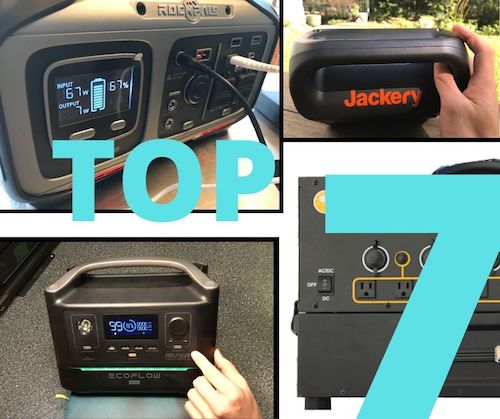
Selecting the best solar generator not only provides you power during a camping trip or power outages but also can save your life during emergencies like natural disasters.
Based on your budget and requirements, there are solar generators that can simply power small devices like phones all the way up to power tools and full-size refrigerators.
We have opted for the Jackery Explorer 240 portable power station as our best small generator and the Point Zero Energy Titan as the best large solar generator from this list.
Choose one that’s capable enough to solve your energy requirements with the help of the above review.
Continue Reading:
What Can a Solar Generator Power? (Charging, Capacity, and More)
Monocrystalline Vs. Polycrystalline Solar Panels – What’s the Difference?








